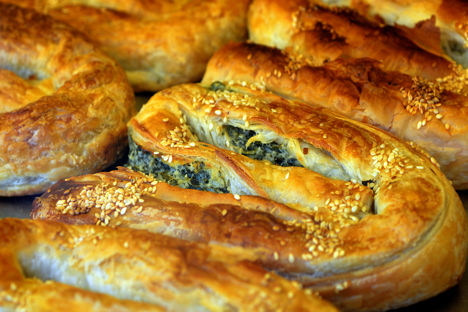
Börek: Turkey’s favourite snack
Helen Graves introduces one of the most common pastries found in the streets of Turkey and how to go about making your own at home.
Börek: Turkey’s favourite snack
Helen Graves introduces one of the most common pastries found in the streets of Turkey and how to go about making your own at home.
As I write this article I’m snacking on a börek, picked up from my local Turkish food shop in London. Rolled and shaped into a large swirl, its layers of fine pastry are filled with a mixture of spinach and salty white cheese; it is rich, super savoury and irresistible to me every time I pass by the shop.
The origin of these addictive pastries is uncertain, but it seems the Turks of Central Asia conceived of them before they moved west to Anatolia. In Turkey today they are absurdly popular; it’s not possible to walk more than a few streets in Istanbul without finding someone selling them. They’re available all across the country in various shapes, sizes and flavours, and with many regional variations. Eaten at breakfast, lunch or any time throughout the day as a snack, there really isn’t a bad time to eat börek.
Traditionally, börek are made with yufka, which is like a very thin flatbread, more substantial than filo but thinner than a flour tortilla, although modern börek recipes have evolved to use pastries such as filo or puff. It is then most commonly filled with combinations of cheese, herbs (most often parsley), local greens, mashed potato or minced meat (such as beef), and rolled or shaped in various ways. There are also many different methods of cooking börek so the result is a wide range of different pastries, around fifty different types; these are some of my personal favourites.
Types of börek
Water börek (Su Böreği): these börek have a very soft texture due to the way they are made; sheets of dough are plunged into boiling water and cooked very briefly before layering in a large dish. A filling (usually cheese and parsley) is scattered sparingly between the layers, which are brushed with butter. It is then baked and cut into squares, to serve.
Cigarette börek (Sigara Böreği): it’s an unappealing name, sure, but it simply refers to the shape of these börek, which are long and thin; some refer to them now as pencil börek instead. Their shape, combined with the fact that they’re fried, means they’re very crisp with the pastry shattering to reveal the filling, which is usually cheese but sometimes minced meat.
Laz börek: a sweet börek which is a regional speciality of Rize in the Black Sea Region of Turkey. It is made by filling the pastry with muhallebi, a rich, wobbly set cream, and is finished with a dusting of powdered sugar – not for the faint hearted.
Rose börek (Gül Böreği): many will be familiar with the snail-like shape of these small börek, which are commonly filled with a combination of cheese and spinach (or other greens), or cheese and minced black olives. They are made with huge sheets of very fine dough, which is then filled along its longest edge and rolled into a tube before curling into a spiral shape.
Arm börek (Kol Böreği): these are like a large version of rose börek. The pastry is much larger, and so the börek is prepared in one long roll, which is then coiled around into a baking tray and cooked slowly in the oven at a low temperature until the sides and top are golden brown. The börek is then cut into cake-shaped wedges to serve.
Muska börek: These are filled and shaped into triangles, like Indian samosas. Most often filled with spinach and cheese and fried or baked, they are a popular style.
Borekitas: These are little pies, a recipe popular among the Jewish communities of Turkey, interesting because they are so different in their shape to the rest of Turkish börek. In her Book of Jewish Food Claudia Roden describes them as ‘the pride and joy and the trademark of the Sephardi table’. Shapes and fillings vary between communities, as ever, and common fillings are, again, spinach, cheese or meat, with interesting regional variations, like aubergine or chickpea.
Tips for making börek at home
Try to get yufka that is as fresh as possible; in Turkey this is much more readily available. The fresher the yufka, the easier it is to work with. If you’re unable to find it, use three sheets of filo, brushed with clarified butter and laid on top of one another.
Don’t overfill your börek, as that can lead to bursting in the oven. Börek should be quite sparsely filled so that the filling doesn’t overwhelm; remember: salty cheese and minced meat fillings are already strong flavours.
You’ll need to use some melted butter or oil to brush between your layers. If using butter (my personal choice) then you’ll need to clarify it by heating gently and skimming off the milk solids.
Popular fillings like spinach and cheese are everywhere because they’re fantastic but it’s worth exploring some of the less well-known fillings, such as aubergine or fish. Really, almost anything can go inside a börek.
Börek freeze really well uncooked - make loads of them so you can keep a good stash.
The best accompaniment to a fresh börek is a glass of sweet Turkish tea.

